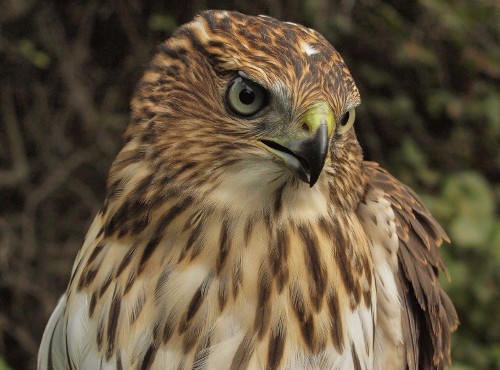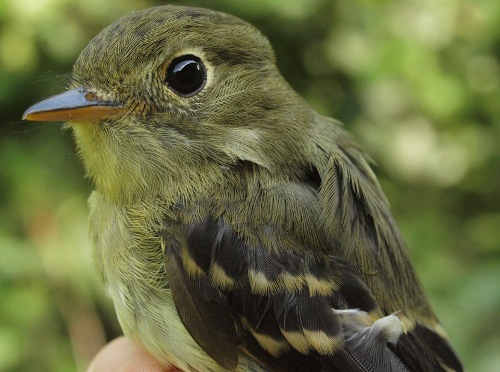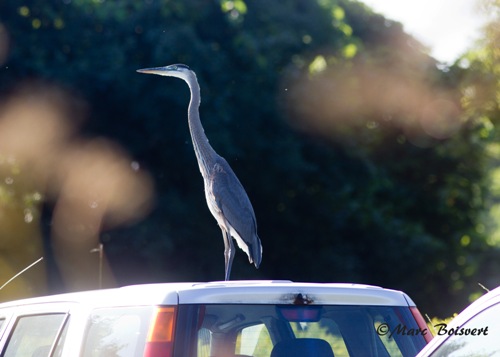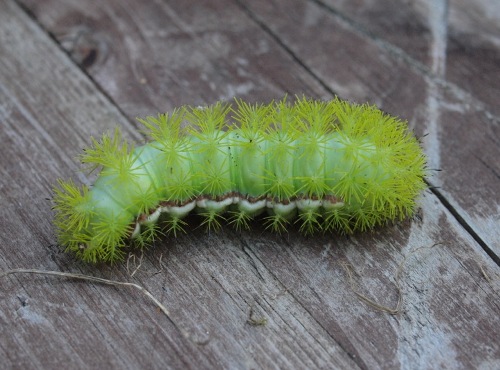|
Week 4: August 22-28, 2014 |
Welcome
to the McGill Bird Observatory weekly report.
Click here for a complete listing of our archives.
Comments or
questions are welcome at "mbo AT migrationresearch.org".
|
PICTURE
OF THE WEEK: |
|

The star of the week was this hatch-year Cooper's Hawk, only the fourth one
banded at MBO in ten years.
(Photo by Simon Duval)
-
|
|
|
THIS WEEK |
THIS FALL |
2014 TOTAL |
SITE TOTAL |
|
# birds (and species) banded |
296 (38) |
809 (54) |
2308 (78) |
48618 (113) |
|
# birds (and species) repeat |
61 (17) |
196 (34) |
535 (48) |
9669 (70) |
|
# birds (and species) return |
8 (6) |
30 (14) |
170 (30) |
1604 (38) |
|
# species observed |
87 |
110 |
147 |
209 |
|
# net hours |
537.0 |
2001.0 |
5414.4 |
84597.7 |
|
# birds banded / 100 net hours |
55.1 |
40.4 |
42.6 |
57.5 |
|
|
Note: table does not include nocturnal banding (owls) |
|
Banders-in-charge: Simon Duval and Gay Gruner
Assistants: Angelika Aleksieva,
Johannie Bernard, Sue Bishop, Marc Boisvert, Cindy Bouchard, Marie-France Boudreault, Manon Bourdon, Luke Currin, David Davey, Geneviève Dubois, Jo-Annie Gagnon, Alison Hackney, Frédéric Hareau, Lisa Keelty, Agathe Lebeau, Marcel Lebeau, Barbara MacDuff, Francine Marcoux, Betsy McFarlane, Ana Morales, Ted Murphy-Kelly, Ahmad Shah, Patricia Stotland, Elise Titman, Rodger Titman, Christiane Tremblay, Michel Vorasane
Notes:
We breathed a sigh of relief as migration finally showed signs of kicking into high gear. The 296 birds banded this week more than doubled last week’s total, and was also the second-highest ever count for this point in the season (behind only the 330 during this week last year). The diversity of species observed also remained well above average, with 87 species over the course of the week, just one less than last year’s record high. Also consistent with the trend, the number of returns so far this fall (30 to date) is just short of record pace.

Yellow-bellied Flycatchers were banded at MBO this week in unprecedented numbers.
(Photo by Simon Duval)
|
We only banded one new species for the year this week, but it was a notable one – Cooper’s Hawk. This was only our fourth individual banded in MBO’s history, although we have now had one in each of the past three fall seasons. Another four species were banded for the first time this fall – Hermit Thrush, Northern Parula, Black-throated Green Warbler, and Wilson’s Warbler.
This week’s top 10 [last week's rank in brackets]
# individuals banded |
mean # individuals observed daily |
1. Tennessee Warbler (56) [2] |
1. American Robin (30) [2] |
2. Magnolia Warbler (40) [2] |
2. American Goldfinch (25) [3] |
3. Northern Waterthrush (18) [8] |
3. American Crow (22) [4] |
4. Common Yellowthroat (16) [8] |
4. Cedar Waxwing (21) [6] |
5. Yellow-bellied Flycatcher (15) [-] |
5. Black-capped Chickadee (19) [8] |
5. American Redstart (15) [1] |
6. Common Grackle (14) [1] |
7. Nashville Warbler (13) [-] |
7. Tennessee Warbler (14) [-] |
7. Song Sparrow (13) [4] |
8. Blue Jay (12) [9] |
9. Red-eyed Vireo (11) [8] |
9. Red-eyed Vireo (9) [-] |
10. Least Flycatcher (10) [-]
|
10. Magnolia Warbler (9) [-] |
|
The wave of migration that swept through MBO this week shook up the composition of dominant species a fair bit. Whereas American Redstart had dominated the banding totals over the first three weeks of the season, it tumbled into a tie for fifth place, with two of the “mid-fall” warblers (Tennessee and Magnolia) arriving in big numbers, while Northern Waterthrush and Common Yellowthroat also increased to land in the top four. This is typically the point in fall when Magnolia Warblers take over, having been the top species banded for week 4 in seven of nine previous years. However, like last year, Tennessee Warbler came out ahead again this year. Without question though, the week’s biggest surprise was Yellow-bellied Flycatcher – easily a single-week record for the species, and more than we’ve banded in several entire seasons. The same applies for Least Flycatcher, despite a somewhat smaller total, and especially noteworthy as over the past three years our fall season total for the species has ranged from 3 to 8. Rounding out this week’s top ten, we continued to band modest numbers of Song Sparrows and Red-eyed Vireos, and Nashville Warblers also began to make their presence known.
After last week being displaced from the top spot for the first time this fall, American Robin again was the most common species observed this week, part of an “all-American” top three that also included American Goldfinch and American Crow. Common Grackle fell back toward the middle of the top ten, while Black-capped Chickadee increased a bit compared to last week. Reflecting the large numbers we banded, Tennessee and Magnolia Warblers showed up in the bottom part of the top ten of species observed, as did Red-eyed Vireo this week. Blue Jay numbers have remained steady so far throughout August.
|

This Great Blue Heron took us by surprise this week when it landed on the roof of one of our volunteer's cars in the parking area!
(Photo by
Marc Bosivert)

An impressive looking caterpillar of the io moth (Automeris io)
(Photo by Simon Duval)
|




